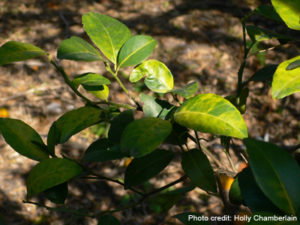
Huanglongbing (HLB)
About
Huanglongbing (HLB), also known as citrus greening, is a bacterial disease caused by the bacteria known as Candidatus Liberibacter asiaticus. It is one of the most devastating diseases for citrus trees worldwide.
Biology
Candidatus Liberibacter asiaticus is brought to citrus trees by Asian Citrus Psyllids. When the psyllids consume a citrus tree's sap, the bacteria is transmitted from the insect's salivary glands. The bacteria cannot grow outside of the secondary host, making it impossible to cultivate to find a treatment.
Preferred Host
Candidatus Liberbacter asiaticus hosts on citrus trees Asian Citrus Psyllids feed upon. These include Chinese box-orange, curry leaf, finger-lime, grapefruit, key lime, kumquat, lemon, lime, lime berry, mandarin orange, mock orange, orange, orange jasmine, pomelo, sour orange, sweet orange, tangerine, and trifoliate orange.
What to Watch For
Fruit trees infected with HLB have poorly colored, lopsided, hard fruit containing aborted seeds.
Look out for fruit that is still green when ripe as well.
It is also essential to watch for any small grey-brown aphid-sized insects, as Asian Citrus Psyllids are the bacteria's secondary host.
Trees infected will also exhibit signs of twig dieback and canopy thinning.
Economic Impacts
Huanglongbing translates to yellow dragon disease and originated in China. The disease has since spread to the southern U.S. because of Asian Citrus Psyllids. This disease has no cure, and it is important to use rapid tree removal to prevent the spread of the disease.

| Common names | HLB, citrus vein phloem degeneration (CVPD), citrus greening disease, yellow shoot disease, leaf mottle yellows in the Philippines, citrus dieback in India |
|---|---|
| Causal agents | Candidatus Liberibacter spp. (L. asiaticus, L. africanus, L. americanus)[1] |
| Hosts | citrus trees |
| Vectors | Diaphorina citri, Trioza erytreae |
| EPPO Code | 1LIBEG |



